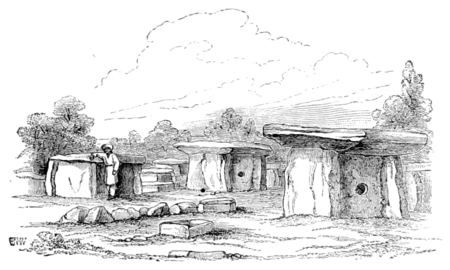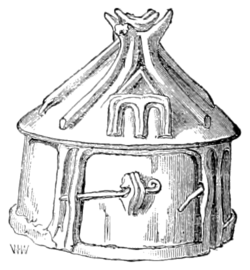have had no means of producing fire before their acquaintance with Europeans, but to have only carried lighted brands from place to place. Sir John Lubbock, however, is now able to give (p. 440) a drawing of a Tasmanian fire-drill. It is just like the well-known instrument of Australia, Africa, and America.
So again, in a less degree, with those rude stone menhirs, cromlechs, kistvaens, &c., which are classed under the head of Megalithic monuments. The range over which these interesting structures are found has been continually extending to new districts. Dr. Hooker's account, in his Himalayan Journals, of the modern setting up of Megalithic structures by indigenous tribes in India, received for years little notice, but has now become one of the leading facts of prehistoric archæology. As may especially be seen in Meadows Taylor's recent paper in the Journal of the Ethnological Society, monuments like our own Kit's Coty House, or Dance Main, are known in vast numbers in India, and are made the subject of careful study. A group from the reduced plate in Sir John Lubbock's work (p. 120) is given here.
Was the civilisation of the lower races spread from a single centre, or from many? Is the correspondence of savage culture the result of common inheritance, or independent similar invention? This still most obscure problem is intimately connected with the evidence brought forward in Sir John Lubbock's generalisations, and especially with his details of modern savage tribes as representatives of older strata of prehistoric man. The point is one which especially strikes those who notice the surprising similarity of the implements of the lower races in the most different regions, as where, in the present work, three all but identical arrow-heads from modern North and South America and ancient France, are set side by side (p. 99); or modern savage flint scrapers are figured, undistinguishable from those of remote European antiquity, Sir John Lubbock insists with much force (p. 545) on the consideration that this similarity is due especially to similarity of materials; that the pointed bones used for awls are necessarily similar everywhere, that obsidian knives from Mexico are like the flint knives of our own country, not so much because the ancient Briton resembled the Aztec, as because the fracture of flint is like that of obsidian. And his remark (p. 121), that any child with a box of bricks will build dolmens and triliths is a highly reasonable protest against those antiquaries who interpret the similarity of Megalithic structures in different districts as proof that their builders were of kindred race.
With regard to a most interesting topic treated of by Sir John Lubbock, that of the existence of savage tribes destitute of religion, I am disposed to entertain a view different from his. To a great extent, indeed, our difference is rather nominal than real. He adopts a definition of religion more stringent than I do, and thus excludes from the catalogue of religious tribes many which on the same evidence I should include. Dieffenbach's evidence, for instance, is quoted as follows (p. 556): "If we take religion in its common meaning, as a definable system of certain dogmas and prescriptions, the New Zealanders have no religion. Their belief in the supernatural is confined to the action and influence of spirits on the destiny of men, mixed up with fables and traditions." This, from my point of view, is an admission that the New Zealanders have a religion; and, indeed, we know that they are strong believers in a future existence, and regard the names of their ancestors as tutelary spirits. Moreover, the assertions of travellers on this point not seldom break down on closer scrutiny. Thus mention is made here of a statement in the Voyage de l'Astrolabe that the Samoans have no religion; but the explorers' information was evidently insufficient, and an elaborate account of the Samoan deities, priests, temples, prayers, sacrifices, may be found in Turner's "Polynesia." Among Sir John Lubbock's list of evidence there are, indeed, cases which cannot be thus easily met. But while admitting theoretically that a state without religion may have prevailed among early tribes of men, and may still be represented by surviving savages, I fail to find as yet any indisputable case.
Among the special points of interest introduced in the present volume, it may be mentioned that the habitations men lived in during the Bronze Age are displayed in a very interesting way, in imitative terra-cotta urns of the



